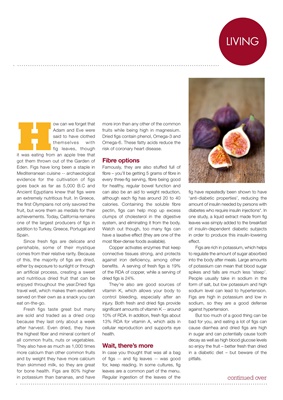
H
ow can we forget that
Adam and Eve were
said to have clothed
themselves with
fig leaves, though
it was eating from an apple tree that
got them thrown out of the Garden of
Eden. Figs have long been a staple in
Mediterranean cuisine -- archaeological
evidence for the cultivation of figs
goes back as far as 5,000 B.C and
Ancient Egyptians knew that figs were
an extremely nutritious fruit. In Greece,
the first Olympians not only savored the
fruit, but wore them as medals for their
achievements. Today, California remains
one of the largest producers of figs in
addition to Turkey, Greece, Portugal and
Spain.
Since fresh figs are delicate and
perishable, some of their mystique
comes from their relative rarity. Because
of this, the majority of figs are dried,
either by exposure to sunlight or through
an artificial process, creating a sweet
and nutritious dried fruit that can be
enjoyed throughout the year.dried figs
travel well, which makes them excellent
served on their own as a snack you can
eat on-the-go.
Fresh figs taste great but many
are sold and traded as a dried crop
because they last only about a week
after harvest. Even dried, they have
the highest fiber and mineral content of
all common fruits, nuts or vegetables.
They also have as much as 1,000 times
more calcium than other common fruits
and by weight they have more calcium
than skimmed milk, so they are great
for bone health. Figs are 80% higher
in potassium than bananas, and have continued over
LIVING
more iron than any other of the common
fruits while being high in magnesium.
Dried figs contain phenol, Omega-3 and
Omega-6. These fatty acids reduce the
risk of coronary heart disease.
Fibre options
Famously, they are also stuffed full of
fibre - you'll be getting 5 grams of fibre in
every three-fig serving, fibre being good
for healthy, regular bowel function and
can also be an aid to weight reduction,
although each fig has around 20 to 40
calories. Containing the soluble fibre
pectin, figs can help mop up excess
clumps of cholesterol in the digestive
system, and eliminating it from the body.
Watch out though, too many figs can
have a laxative effect (they are one of the
most fiber-dense foods available).
Copper activates enzymes that keep
connective tissues strong, and protects
against iron deficiency, among other
benefits. A serving of fresh figs is 19%
of the RDA of copper, while a serving of
dried figs is 24%.
They're also are good sources of
vitamin K, which allows your body to
control bleeding, especially after an
injury. Both fresh and dried figs provide
significant amounts of vitamin K -- around
10% of RDA. In addition, fresh figs about
13% RDA for vitamin A, which aids in
cellular reproduction and supports eye
health.
Wait, there's more
In case you thought that was all a bag
of figs -- and fig leaves -- was good
for, keep reading. In some cultures, fig
leaves are a common part of the menu.
Regular ingestion of the leaves of the
fig have repeatedly been shown to have
'anti-diabetic properties', reducing the
amount of insulin needed by persons with
diabetes who require insulin injections*. In
one study, a liquid extract made from fig
leaves was simply added to the breakfast
of insulin-dependent diabetic subjects
in order to produce this insulin-lowering
effect.
Figs are rich in potassium, which helps
to regulate the amount of sugar absorbed
into the body after meals. Large amounts
of potassium can mean that blood sugar
spikes and falls are much less 'steep'.
People usually take in sodium in the
form of salt, but low potassium and high
sodium level can lead to hypertension.
Figs are high in potassium and low in
sodium, so they are a good defense
against hypertension.
But too much of a good thing can be
bad for you, and eating a lot of figs can
cause diarrhea and dried figs are high
in sugar and can potentially cause tooth
decay as well as high blood glucose levels
so enjoy the fruit - better fresh than dried
in a diabetic diet - but beware of the
pitfalls.